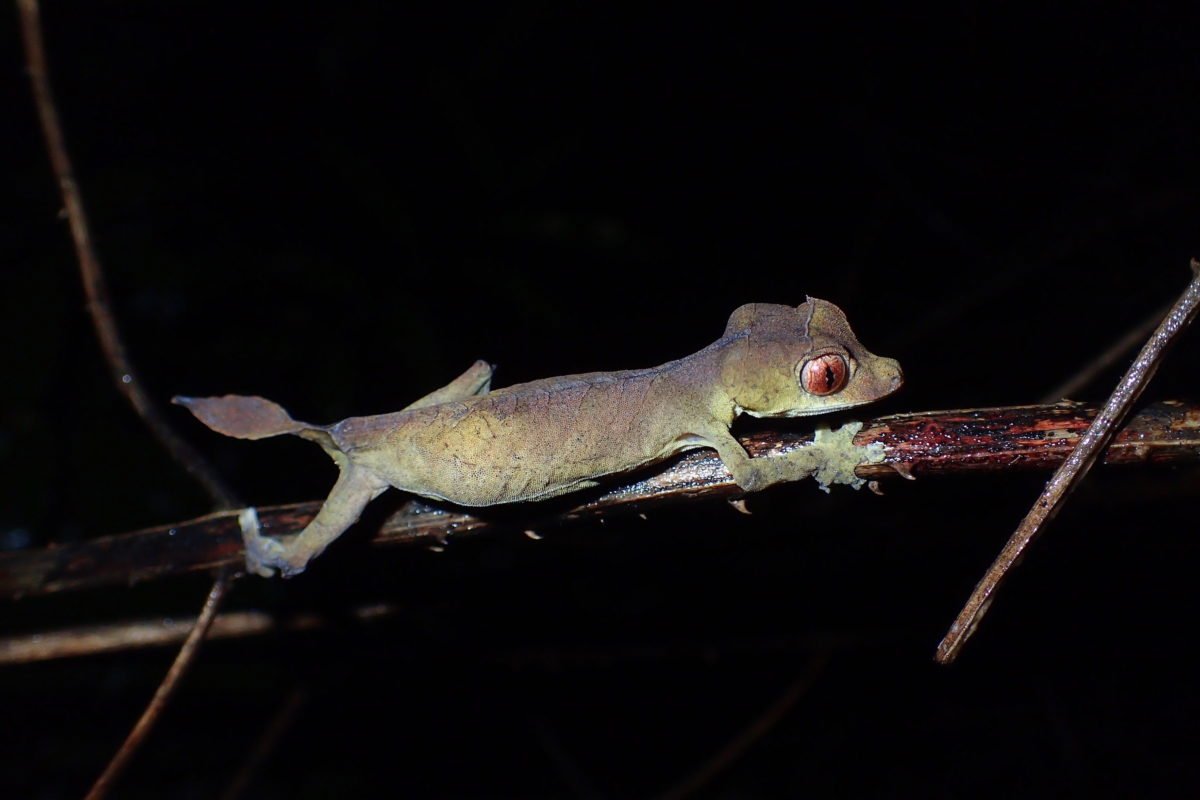- Scientists have described a new species of leaf-tailed gecko, Uroplatus fetsy, believed to be found only in Madagascar’s Ankarana Special Reserve.
- All Uroplatus species are endemic to Madagascar and are best known for their leaf-like tails and coloration that allow them to blend into the foliage.
- Though newly described, U. fetsy may already be at risk: the dry deciduous forests of the reserve are severely threatened by illegal logging, cattle grazing, fires, and artisanal mining.
- The authors of the paper describing the new species say it could warrant endangered status on the IUCN Red List because of these threats to its habitat.
Until they looked into the mouth of a leaf-tailed gecko collected in Madagascar last year, scientists couldn’t be sure they were looking at a new species of lizard. The specimen looked remarkably similar to a known species, Uroplatus ebenaui, known as the spearpoint leaf-tailed gecko and found only in Madagascar.
Indeed, when the first specimen was collected in 2004, it was believed to be of an U. ebenaui. At first glance, apart from a slightly longer tail and smoother skin on its back, there was little to distinguish it from the spearpoint leaf-tailed gecko. The first clue to its distinctiveness came from its genetic differentiation from U. ebenaui. “We then had to find more animals to make sure that these genetic results were not an anomaly,” said Mark D. Scherz, a herpetologist at the Bavarian State Collection of Zoology in Munich.
A tissue sample collected in 2011 confirmed the genetic differences. However, it wasn’t until scientists got their hands on a new specimen in 2018 that the morphological differences became evident. The inside of U. ebenaui’s mouth is totally black, while the new species has red patches on the sides of its mouth cavity. (Mouth coloration has emerged as an important distinguishing feature for geckos in this genus. Another recently described Uroplatus species, U. finaritra, was identified in part from its mouth color.)

The new species, also known only from Madagascar, has now been formally described as Uroplatus fetsy in a recent paper in the journal Zootaxa. The name comes from the Malagasy word for “sly,” in reference to the species’ elusiveness and the way its mouth appears to curl upwards giving the impression of a wicked smile.
“The species was discovered quite a long time ago, but we didn’t manage to collect enough individuals for a long time because it is very rare and hard to find,” Scherz said.
U. fetsy is found in and around Ankarana Special Reserve in northwest Madagascar, where dry savanna and dry deciduous forests mingle with towering jagged limestone formations that date back to the Jurassic Period, called tsingy. Spread across 182 square kilometers (70 square miles), the park has thrown up new species with astonishing regularity.
The newly described gecko appears to be restricted to the reserve, while U. ebenaui enjoys a wider range in northern Madagascar. But the forests of Ankarana are under severe threat from illegal logging, cattle grazing, fires, and artisanal mining. Given the new species’ limited range and the pressures it faces, the authors of the recent paper recommend classifying it as near threatened or endangered on the IUCN Red List. The wider-ranging U. ebenaui is listed as vulnerable.
“Although it is found inside a protected area, the forests around Ankarana are often being burned or cut down, so the species may be endangered,” Scherz said. “But we don’t know if it might be a little more widespread, which would reduce the risk somewhat.”
Leaf-tailed geckos are nocturnal creatures, best known for their tails that resemble dead leaves or tree bark and that, along with their coloration, allow them to blend into the foliage. (Uroplatus comes from the Greek words for “tail” and “flat.”) Prior to the description of U. fetsy, there were 18 recognized species in the genus Uroplatus, all endemic to Madagascar.
But the Bavarian State Collection of Zoology alone holds specimens of several candidate Uroplatus species that remain undescribed. Madagascar, the fourth-largest island in the world, supports a breathtaking array of endemic species due to its long geographic isolation. Some scientists fear that some of these species are being driven to extinction even before we become properly acquainted with them.
Citation:
Ratsoavina, F. M., Scherz, M. D., Tolley, K. A., Raselimanana, A. P., Glaw, F., & Vences, M. (2019). A new species of Uroplatus (Gekkonidae) from Ankarana National Park, Madagascar, of remarkably high genetic divergence. Zootaxa, 4683(1), 84-96. doi:10.11646/zootaxa.4683.1.4
Banner Image: A specimen of the recently-described Uroplatus fetsy. Image Courtesy: Mark D. Scherz
Malavika Vyawahare is the Madagascar staff writer for Mongabay. Find her on Twitter: @MalavikaVy
FEEDBACK: Use this form to send a message to the author of this post. If you want to post a public comment, you can do that at the bottom of the page.
